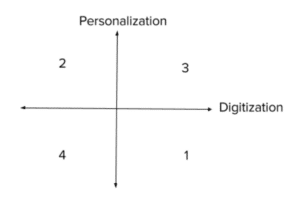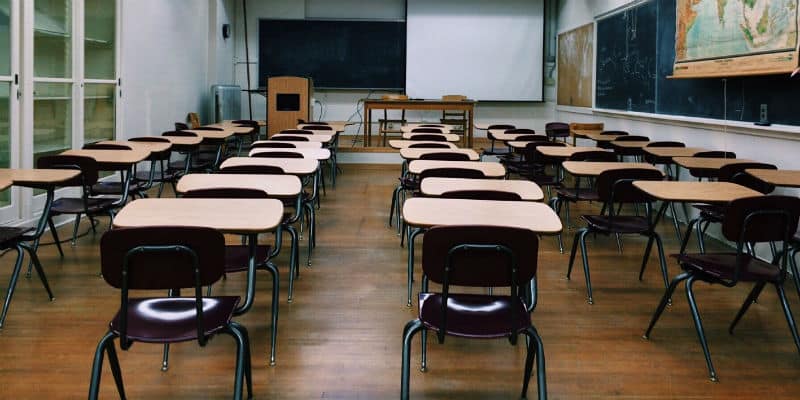Our guest blogger Elizabeth Anthony leads blended-learning implementations in K–12 Catholic schools as the blended-learning coordinator for the Alliance for Catholic Education (ACE). She blogs regularly on blended learning for Notre Dame ACE Academies.
As technology has been on the rise in education, traditional instruction has simultaneously been demonized. Education innovators posit that classrooms have hardly changed since the industrial era when they were designed to “produce” students with a certain set of knowledge and skills in the same way a production line at a factory churns out identical products; they argue that technology has the potential to personalize learning by customizing learning experiences or using time and space in creative ways, typically with a model of blended learning.
Now, I want to say first and foremost that I champion blended learning specifically because of the myriad benefits I know this model can have for students. Blended models can eliminate learning gaps, increase engagement, and foster ownership, and that is just the beginning. I also believe that a more personalized education experience that appeals to each student’s unique strengths is what our scholars deserve and will be the future of education for generations to come.
Adding adaptive software programs to a classroom with many of the same factory- and production-oriented structures, however, will likely not accomplish this end.
Defining Digitization vs. Personalization
In my experience, the magic of blended learning lies in the instructor’s ability to leverage technology to personalize learning rather than the mere use of certain software programs. A classroom can incorporate technology without actually changing the classroom model and the way students learn. The simple graphic below helps to visualize how technology and personalizing learning may work together (or not) in the classroom. To illustrate my point, I want to present two scenarios for you to consider, one from quadrant one (highly digitized, but not particularly personalized) and one from quadrant two (highly personalized, but not digitized).

A Factory Blended Model
First, consider a teacher who gets a new set of Chromebooks and decides to “go blended.” The teacher splits her students into three performance-based groups in August and, for the remainder of the year, the students rotate in these groups through stations during math and ELA. One of the three stations is the technology station where students use an online program to learn at their own pace, but the rest of the students’ work stays pretty much the same. The teacher repeats her lesson three times each class and rarely reflects on her students’ data. Her students seem to enjoy whatever it is they do on the computer so she proceeds with the model. This is a perfect example of quadrant one above: the teacher is digitizing part of the students’ work to offer a bit more control over the pace of learning, yet she is not using the technology to its full potential by giving students significantly more control over the time, place, or path of their learning.
A Tech-Free Personalized Model
Now imagine a teacher who does not use online learning programs but is widely considered to be an outstanding teacher. This teacher has a clear purpose for every lesson and the students can articulate this purpose as well as why it is relevant to them. Throughout each class period, students are highly engaged in rigorous thinking, discussion, and collaboration related to the lesson’s purpose. They apply their knowledge to new contexts in meaningful ways. Every student is expected to master the same objective by the end of class, but the teacher offers different levels of support to different learners through creative groupings and flexible activities. This reflects a classroom in quadrant two–the teacher takes pains to personalize learning to each student, but technology is nowhere in sight. This scenario appeals to those who argue that personalization ispossible without digitization, and many would argue that this scenario is actually preferable to the digitized, factory-oriented model from the first scenario.
Seeing Past the False Dichotomy
These examples are overly simplistic. But they do beg the question: what sort of classroom are we inadvertently creating if we simply digitize the factory model itself? The key to blended success is to move beyond these two simplistic scenarios to combine the affordances of both. If teachers can combine the high-yield practices from scenario two with the tools from scenario one, we can move towards a rigorous and highly personalized model of education that is actually sustainable for students and teachers.
Personalizing learning without technology is a daunting task reserved for some of our nation’s best teachers. But it can be made more feasible with the software programs and tools available to us today. What we must remember, however, is that technology combined with depersonalized classroom structures reminiscent of the factory model will not accomplish this ultimate goal.
For blended-learning models to have their fully transformative impact, teachers must help students understand the purpose and relevance of their learning, consistently employ formative assessment strategies and respond to the results, and be able to offer students distinct paths to reaching meaningful learning goals. These skills are not unique to blended classrooms – as I said before, teachers have been employing these strategies without technology for years. But they are of the utmost importance for blended models to reach their potential to personalize.



